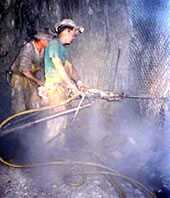AEROSOLS

This page provides links to a variety of information regarding the measurement, control, exposure characterization and health effects associated with aerosols in the workplace. The definition of an aerosol, as used here, is a suspension of tiny particles or droplets in the air, such as dusts, mists, or fumes. These particles may be inhaled or absorbed by the skin, and can sometimes cause adverse heath effects for workers. NIOSH has carried out extensive research to minimize the adverse health effects associated with aerosol exposures. Results of such research are available through the links on this page.
NIOSH Aerosol Research
NIOSH Aerosol Research OverviewProvides an overview of ongoing aerosol-related research projects in the field and in NIOSH laboratories. List of Active internal NIOSH research projects related to aerosols
External NIOSH research projects related to aerosols may be found several ways:
- Browse NIOSH Extramural Research Awards in Fiscal Year 2003 - New and Continuing Grants and Cooperative Agreements [PDF - 832 KB]
-
Search
- Suggested search terms: aerosol respir%
- Institutes and Centers field: select CDC
- More information may also be found at the NIOSH Office of Extramural Programs Web site .
NIOSH researchers have developed a prioritized list of research and policy needs, and identified areas where they are looking for opportunities to collaborate with external research partners, scientists, and organizations.
Aerosol Sampling
Cyclone Bioaerosol SamplerWhile looking for ways to improve the collection and analysis of bioaerosols, a NIOSH scientist has developed a new design for a cyclone bioaerosol sampler. Acyclone samplerdraws air into a cylindrical chamberwhere the air flow is rotated. Particles of a sufficiently large size move toward the walls of the chamber by centrifugal force, where they are collected.
NIOSHTIC-2 Search
NIOSHTIC-2 is a searchable bibliographic database of occupational safety and health publications, documents, grant reports, and journal articles supported in whole or in part by NIOSH.
Selected Query Results:
- Aerosols, Sampling and Measurement
- Aerosol Exposure
- Aerosols, Control, Filtration, Ventilation
- Aerosols and Health Effects
Aerosol 101: Helpful Tutorials
Generation and Behavior of Airborne Particles (Aerosols)
Aerosol 101
[PDF - 347 KB]
Disclaimer: The following links in this section go to web sites outside of CDC/NIOSH and should not be considered as an official endorsement of their content, or as a statement of NIOSH policy.
Aerosol Science & Engineering
This interactive program is designed for aerosol science and engineering education at the introductory level. It was created by the University of Florida and Washington University in St. Louis through the support of National Science Foundation Grant.

Aerosol Dictionary
Provides a variety of information on aerosol instrumentation, terminology, more...
Aerosol Short Course
Brochure describing the annual 3-day seminar offered by the University of Minnesota.
NIOSH Resources
Hazard Control 30: Control of Drywall Sanding Dust Exposures
DHHS (NIOSH) Publication No. 99–113
This document details several methods to control exposure to high concentrations of dusts from sanding drywall joint compound.
Handbook for Dust Control in Mines
DHHS (NIOSH) Publication No. 2003-147
Describes effective methods for the control of mineral dusts in mines.
NIOSH Manual of Analytical Methods (NMAM)
DHHS (NIOSH) Publication No. 94-113 (1994)
NMAM is a collection of methods for sampling and analysis of contaminants in workplace air, and in the blood and urine of workers who are occupationally exposed.
NIOSH Pocket Guide to Chemical Hazards
DHHS (NIOSH) Publication No. 97-140
Exposure limits, Respirator Recommendations, First Aid, more...
The Pocket Guide is a source of general industrial hygiene information on several hundred chemicals/classes found in the work environment. Key data provided for each chemical/substance includes name (including synonyms/trade names), structure/formula, CAS/RTECS Numbers, DOT ID, conversion factors, exposure limits, IDLH, chemical and physical properties, measurement methods, personal protection, respirator recommendations, symptoms, and first aid.
National Occupational Research Agenda - Emerging Technologies
The NORA Emerging Technologies Team is working to establish mechanisms to ensure that worker health and safety is considered when new technologies are developed and implemented
RTECS is a compendium of toxicological information extracted from the open scientific literature.
Other Related NIOSH Topics
- Pesticides
- Pneumoconioses
- Respirators
- Respiratory Disease Surveillance
- SARS
- Silica/Silicosis
- H1N1 Influenza Virus (Swine Flu)
- Ventilation in Mining
Other Resources / Organizations
Disclaimer: The following links in this section go to web sites outside of CDC/NIOSH and should not be considered as an official endorsement of their content, or as a statement of NIOSH policy.
AAAR
Aerosol-related links page.
Aerosol Calculator
A downloadable spreadsheet for calculating aerosol properties and behaviors.
CIIT (Centers for Health Research)
A source for the multiple path particle
dosimetry model.
ICRP (International Commission on Radiological Protection)
A source for lung deposition modeling software.
NRC Report
Research priorities for particulate matter
National Nanotechnology Initiative
A U.S. government initiative to organize nanotechnology research, started in 2001
The Particle Atlas
A collection of electron micrographs of many typical aerosol particles
Particulate Matter Research Activities
This website is being developed to assist in particulate matter research, and to support the activities of the National Research Council Committee on Research Priorities for Airborne Particulate Matter. The site is run by HEI and EPA, but covers industry and academia as well as government activities.
Journals:
Aerosol Science & Technology
Annals of Occupational Hygiene
Atmospheric Environment
Atomization and Sprays
Journal of Aerosol Research, Japan
Journal of Aerosol Science
Journal of Aerosols in Medicine
Journal of the Air Waste Management Association
Journal of Colloid and Interface Science
Journal of Nanoparticle Research
Journal of Occupational and Environmental Hygiene
Environmental Science and Technology
Particle & Particle Systems Characterization
Particulate Science and Technology
Powder Technology
- Page last reviewed: June 29, 2010
- Page last updated: June 29, 2010
- Content source:
- National Institute for Occupational Safety and Health Education and Information Division


 ShareCompartir
ShareCompartir